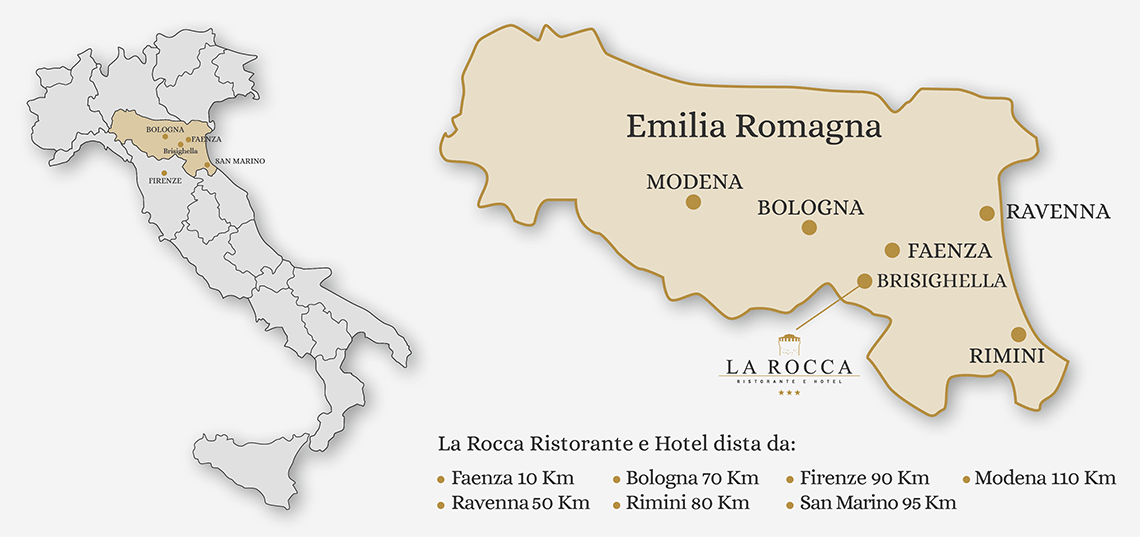Brisighella, one of the most beautiful villages of Italy, offers a variety of itineraries for all tastes. Spend a day dedicating yourself to art and history , keeping in mind the “cardinal rule”: the village is a “Slow” cityto be enjoyed at a leisurely pace.
The Lamone Valley, enhanced by the Via Faentina, built by the Romans, still has dwellings from the Neolithic Age. The origins of this medievil village date back to the construction of the Clock Tower at the end of the 13th Century on one of the three hills at whose feet the village developed.
Brisighella is composed of a labyrinth of medievil alleys and walled streets but what defines it most is the three hills: La Rocca (Castle), The Clock Tower and the Santuario del Monticino Church which create the backdrop to this unique hamlet.
The “Antica Via Del Borgo” also known as “Via Degli Asini” (Donkey’s Way) because it offered shelter to the animals of the Biroccai (coachmen) – who lived there, is one of the most enchanting places in Brisighella and is famous for its’ particular architectural form.
Brisighella’s Town Hall, whose façade is in the Palladian Neo-Classical style was built between 1824 and 1828 by the engineer Antonio Melari. The coat of arms of the village; the Prancing Goat, is on the main Entrance Door.
Giuseppe Ugonia (1881 – 1944) illustrious painter and lithographer of our region, whose works have also been on display in the British Museum in London, displays in his works, his poetic vision of the village which inspired his most beautiful pieces.
Museum Tickets which include entrance to the Rocca (Castle) are only €3.00.
Timetable:
From May to September – Everyday including National Holidays: 10:00-12:30hrs, and 15:00-19:00hrs.
April – October – Everyday including National Holidays: 10:00-12:30hrs and 15:00-19:00hrs
November to March – Everyday including National Holidays: 15:00-17:00hrs and National Holidays: 10:00-12:30hrs and 15:00-17:00hrs.
The park, with its’ characteristic monumental fountain, is one of the most loved and visited corners of the village and was created by Giuseppe Ugonia.
This dates back to 1490, the oldest “Brisighellan” fountain, fed by the water from the rocks. Once called the “Fountain of three Jets” (in dialect)
Built in 1310 by the Manfredi family of Faenza – the “Manfredian” and “Venetian” tower is typical of the medievil fortress style. It remained with the family who built it until 1500 when it was passed to Cesare Borgia who owned it until the arrival of the Venetians in 1503. From 1509 it was owned by the Papal state.
La Rocca has recently been restored as well as the walkway and lighting added ,to reach it. Today it is home to a museum dedicated to the relationship between Man and Gypsum.
In the Venetian Tower, the links to the Middle Ages and Renaissance are evident within the Building.
SUMMER TIMETABLE
From May to September: Everyday including National Holidays 10:00-12:30hrs and 15:00-19:00hrs
From 6th June to 8th September – also open from Tuesday – Friday 10:00 – 12:00hrs
April to October: Everyday including National Holidays: 10:00-12:30hrs and 15:00-18:00hrs
WINTER TIMETABLE
November to March: Everyday except National Holidays:
Combined ticket for Museum and Castle La Rocca. €3.00
The first of the three buildings on top of the hills to be erected which, together with La Rocca, constituted the defence system of Brisighella. It was erected by Maghinardo Pagani, the greatest “condottiere” of Romagna but was subsequently completely rebuilt in 1850 when the clock was added.
This hill was called Mount Cozzolo or Calvario and dates back to 1662. The original chapel was then replaced by the current sanctuary
The current sanctuary was built in 1758 and has undergone various renovations over time.
Behind the Sanctuary today there is an outdoor Geological Museum which replaces a quarry which had been there and until recently, extracted chalk.
Travelling from the village towards Tuscany on the State Road No.302, after 8 miles you will find the Parish Church of Giovanni San Battista, also called Pieve Tho’.
A Roman church of extreme simplicity, evocative and unique in its’ beauty. Its’ origins are associated with Galla Placidia, daughter of Theodosius who had it built with the remains of a temple dedicated to Jupter Ammon. Its’ construction on Roman remains appears to date back to between the 8th and 10th Century.
Opening Hours:
15 April to 15 October: National Holidays from 15:00 to 18:00hrs
16 October to 14 April: National Holidays from 14:30 to 16:30hrs
9 June to 12 September: Tuesdays to Saturdays 15:30hrs to 17:30hrs
Information: 0546 81166 (tourist office)
Pro Loco: www.brisighella.org
For guided tours to villages and cities of art in the Emilia Romagna region, tour guides from Brisighella:brisighellatailorguide.com
La Rocca Hotel is an ideal base from which to travel and move around Romagna, thanks to its’ central position and closeness to cities of art, the sea and the Apennines!


We are close to Faenza (10km) known for its ceramics, Imola (27km) and Dozza (36km). Make sure you visit the Byzantine city of Ravenna (55km), the region’s capital Bologna (70Km), Florence (92km) and Ferrara (112km).

The Parco della Vena del Gesso and the Parco delle Foreste Casentinesi has breathtaking views, small villages and magical groups of houses which remain in your heart, all to be enjoyed either on foot or by bicycle.

An afternoon at Cesenatico Port, designed by Leonardo Da Vinci, an evening in Cervia and Milano Marittima, a night in Rimini, Riccione and San Marino. The Romagnola Riviera is a stone’s throw away!